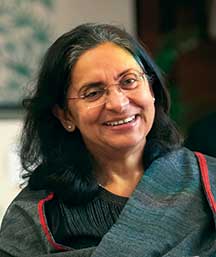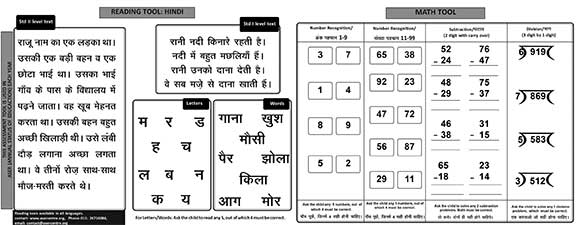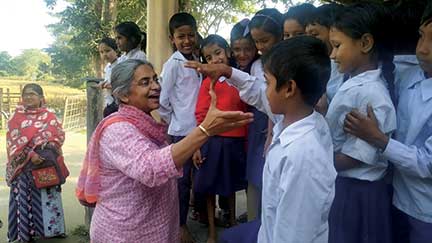Rukmini Banerji is the CEO of Pratham Education Foundation. She was instrumental in setting up and shaping the ASER Centre that leads the ASER (Annual State of Education Report) survey. She’s a Rhodes Scholar at Oxford University and earned her Ph.D. at the University of Chicago. In 2021, she was the recipient of the Yidan Prize for Education Development for her work on improving foundation learning outcomes. Likhitha and Priyanka Rambol engaged in a short email interview with Dr.Banerji to explore learnings from ASER in the last 15 years.

It’s been more than 15 years since the launch of ASER. When you look back, what are your top three learnings from doing the survey year on year?
Simple easy-to-use tools and methods can go a long way in enabling a wide cross-section of society in participating in the effort to understand a problem. Understanding a problem is part of the way to solving the problem. Tracking progress is important to ensure that we persist till progress happens. Being frugal, timely, and predictable have helped the ASER initiative to survive almost two decades.
The 2021 ASER report shows some interesting numbers around increase in enrollment in government schools. Do you anticipate a shift in these numbers in 2022 or 2023, now that schools are fully operational and the economy is slowly coming back to pre-COVID times? We are also keen to hear your thoughts on the effects of high enrollment on teachers and school leaders – particularly in government schools.
We are eagerly awaiting the ASER 2022 data. Despite school closures during COVID, the ASER 2021 data indicated an increase in government school enrollment. In all likelihood, the rise in government school enrollment can be attributed to economic disruptions and distress in families. In addition, in many states, during the pandemic, schools were able to provide dry rations, textbooks and other inputs. ASER 2022 will show us what the status is with school enrollment now that schools have been open and functioning for almost a year.
ASER’s data collection has mostly focused on children aged from 5 to 16; we, therefore, don’t have information about 3 and 4-year-olds who also fall under the purview of India’s new National Education Policy 2020. Do you see ASER including them in future surveys, given the renewed focus on primary learning, more than ever?
ASER is known for its estimates of schooling and learning for children of the elementary school age group. What is less known is that ASER also collects information about where children aged 3 to 5 are enrolled. At this age, there are a variety of options for enrollment; children can go to government – run anganwadi centres, or to private schools with lower and upper KG. In some cases, despite being under-age, children of this age group are also enrolled in formal school in the government and private sector. Across states and over time, there are wide variations in enrollment data. Trends over time for data for the age group 3 to 5 have been very useful in planning where pre-primary classes are needed in government schools and where the pre-school education component can be strengthened in the anganwadi system. (See ASER 2018 Young Children for more details: http://asercentre.org/’Young/Children’/p/369.html. In addition see ASER 2019 Early Years report that has been discussed later in this article). Both of these sources of data shed considerable light on issues that need special focus for the “foundational stage” outlined in the National Education Policy 2020.
This is a follow up to the previous question – We have witnessed examples of ASER previously making an attempt to assess a range of developmental indicators for 4-8 years olds in 2019 through ‘Early Years’ ASER. We are curious to know if ASER plans to look at non-academic abilities during the school years as well, among children 5 to 15 years. If so, what would be some of the key focus areas?
In 2019, a special ASER report was done focussing entirely on the age group 4 to 8. This report was based on data on enrollment as well as children’s competencies on a variety of skills including cognitive, socio-emotional, pre-language and math. (See ASER 2019 Early Years: http://asercentre.org//p/359.html)
The 2017 ASER report was focussed on the age 14 to 18 and looked at a range of topics such as aspirations, activities, awareness and abilities. In addition to reading and arithmetic abilities, efforts were made to understand how young people apply their skills to solve everyday problems.

The usual well-known nationwide ASER has been done every year from 2005 to 2014, and then in 2016 and 2018. After 2014, the idea was that the gap year would be used to focus on a specific age group or theme. This was done for ASER 2017: Beyond Basics for age 14-18 and in ASER 2019: Early Years for age 4-8. Some of the key indicators or tasks from these “gap-year” ASERs can be incorporated into the big survey. In fact, the 2018 ASER survey does have a few tasks for everyday application for the age group 14-16.
For the usual ASER, key elements (such as simplicity, do-ability, one-on-one nature of the assessment, cost, duration and scale) impose constraints on what can be done as part of the household survey. There is also the need to keep each year as comparable to previous years. In upcoming years, it is possible that ASER will explore non-academic characteristics of children. To do this, an in-depth pilot will have to be conducted in a gap year.
ASER 2021 conducted a field-based state-wide learning assessment in Karnataka during the pandemic. It is reported that the reading and arithmetic abilities were alarmingly low. What major breakdowns do you think led to this low learning levels during the pandemic?
In 2021, the ASER teams conducted field surveys in three states: Karnataka survey was carried out in Feb-March before the devastating second wave of COVID, Chhattisgarh was done in October-November, after the second wave and West Bengal in December. Each of these surveys showed a significant drop in learning levels across most grades as compared to the last field survey in 2018*. It is worth reminding ourselves that learning levels were far from satisfactory even before COVID. With schools closed for long periods of time, it is very likely that the losses are due to what children forgot as well as what they did not have an opportunity to learn. Online learning was not possible for a vast majority of elementary school children in rural areas as seen in the ASER 2020 and 2021 surveys.
In one of the surveys in the 2000s, ASER included the parents while assessing the children. It was reported that this initiative led to a lot of interest and curiosity in the parents. In the current times, how do you think we can leverage parents and the community in the learning process?
The ASER surveys have always been done with children in the household. The data collection happens usually on a weekend, especially on a Sunday when all children and family members are likely to be home. Conducting the survey in the household implies that all children, whether enrolled in government school, in private school or not in school, can be assessed. Also, the ASER assessment is done one-on-one – each child is asked to do simple tasks like reading letters, words, small paragraphs or a short 8-10 line story. Similarly, in arithmetic, the child has to recognize numbers, do a basic two digit subtraction problem with borrowing and then a three digit by one digit division. Family members and others from the community often observe the child doing the tasks. This leads to a lot of discussion about what children can do and what they should be able to do and also how they can be helped to achieve these basic levels.

With the NEP and the exponential focus FLN across states, what are three hopes you would like to see come alive in the next 10 years?
The New Education Policy 2020 is very clear in terms of vision and goals especially for the foundational stage. The document conceptualizes a continuum from age 3 to age 8 – calling it the foundational stage. The goals for this stage are also clearly stated.
“Attaining foundational literacy and numeracy for all children will thus become an urgent national mission, with immediate measures to be taken on many fronts and with clear goals that will be attained in the short term (including that every student will attain foundational literacy and numeracy by Grade 3). The highest priority of the education system will be to achieve universal foundational literacy and numeracy in primary school by 2025. The rest of this Policy will become relevant for our students only if this most basic learning requirement (i.e., reading, writing, and arithmetic at the foundational level) is first achieved” NEP2020 document. Section 2.2. Page 8.
As far as building children’s foundation is concerned, NEP2020 provides a much needed and essential push. I have three hopes: first, that the provision of quality education from age 3 to age 8 is seamless – a continuum of provision of high quality education. The opportunity to develop a continuum of provision can lead to the best of the ICDS system being integrated to the best possibilities in the formal school system. Second, developing strong and durable literacy and numeracy skills has to be done by building on a base of “breadth of skills”. Third, family members, like parents, are seen as resources and as essential pillars of helping children learn. Translating this policy into practice will lead to a much higher trajectory of learning for children through their school years.
Lastly, what keeps you motivated to do this work, even after two decades?
I believe that understanding a problem well is half way to solving it. As a society if we can use basic easy to use tools and methods to explore problems and develop simple ways of communicating and discussing them, we will be able to mobilize thousands of people who will seek solutions. Over the years ASER has played a major part in highlighting gaps in our education system and catalysed debates and discussions that have led to accepting the problem and encouraged citizens and governments to seek solutions.
*http://img.asercentre.org/docs/statusoflearning_22.04.pdf
Likhitha is a 2021 Teach For India Fellow working with 50 passionate Grade-5 students in Hyderabad. They can be reached at likhitha.n2021@teachforindia.org.
Priyanka Rambol is a Teach For India Alumnus currently working as the Program Lead with Kshamtalaya Foundation in Delhi. She can be reached at priyanka.rambol2018@teachforindia.org.
Related Article
